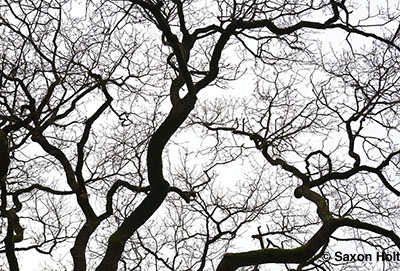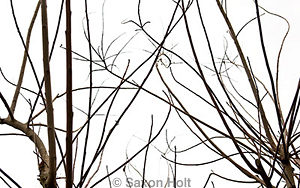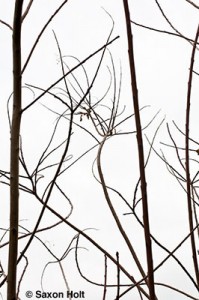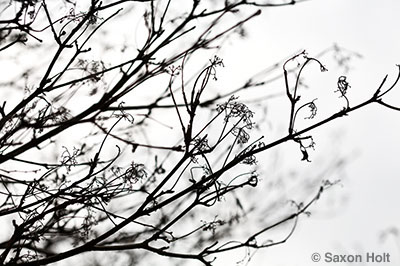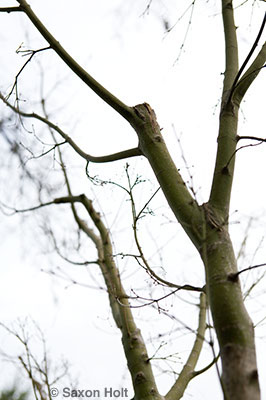Winter’s stark beauty. Color vanishes from the landscape. Bare trees dominate the garden.
On cloudy overcast days, the somber gray sky can become a clean white background, perfect for silhouettes with just a little bit of camera manipulation. You can override your camera meter’s calibration which is designed to read each scene as a neutral gray.
No matter if your camera has a single meter setting, a spot setting, or any number of zone readings, it is designed to render the area it reads as an “average” gray. My un-pruned Cotinus ‘Grace’ has a tangle of branches that offer all sorts of wonderful graphic compositions. I “see” them in my mind’s eye but I have to make the camera lie. I want silhouettes.
To give my compositions the drama I want, I overexpose my photo by 2 full f-stops. I have a very fine camera and shoot with manual controls but most mid price point-and-shoot cameras have a meter compensation button. While it is fairly easy to do the same exposure compensation in post production, back at the computer, you won’t be able to see the full graphic effect in the garden while you are working.
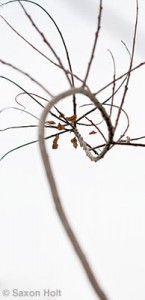 The exposure compensation is only the first step. Composition is what makes a silhouette really work. It is hard to get excited about the murky gray preview photos you will see if your let the meter read everything as gray. Once you brighten up your photos – while you are still taking pictures, it will be easier work on composition.
The exposure compensation is only the first step. Composition is what makes a silhouette really work. It is hard to get excited about the murky gray preview photos you will see if your let the meter read everything as gray. Once you brighten up your photos – while you are still taking pictures, it will be easier work on composition.
I almost always use a tripod when I work. I can carefully align each element and fill the frame with positive and negative space, working the angle ever so delicately to get a balance that pleases me. Sometimes I envision a cropped image which I have to do in the computer, but even then, I will have used the tripod to get my horizontal and vertical lines clean and balanced.
The balance of the lines is all you have to work with for these winter silhouettes and it is much better to spend time thinking about this before you take the picture rather than hoping to make something work out later from a grab shot.
Different plants will suggest different ways to interpret their bare shape. In each case spend some time thinking about filling the entire frame with shape and line. The shape can be negative space or white spaces in these silhouettes, but use your entire frame and let the camera help you compose.
The dried remains of the flowers stems of Viburnum “Summer Snowflake” seem almost to suggest snowflakes on the winter branch.
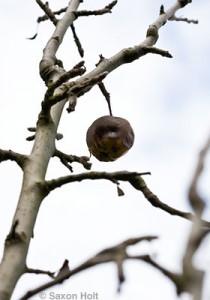 And a remaining apple on the tree gives the photographer a target and fine compositional element.
And a remaining apple on the tree gives the photographer a target and fine compositional element.
A very practical reason to study your deciduous trees and shrubs in winter is to better understand the plant’s own structure and pruning needs.
On fruiting tree it is not just a matter of shaping, now is the time to look at the fruiting spurs and prune for healthy production.
Japanese maple trees benefit especially from proper pruning and mine are works in progress. After 10 years nipping at my own trees I have starting making some large pruning decisions that I hope will give them the characteristic beauty I see in Japanese gardens.
For the time being I will overlook some of the stubby cuts revealed in winter.
So even if it is too cold to set up the tripod and make silhouette photos, go out into your garden now while it is winter and think about your pruning decisions. Any excuse to go into the garden is a good one.
Happy new year to all!
Whoops – postscript here to our loyal GGW friends who take the time to Comment. A new upgrade to WordPress has me mixed up. Rather than adding my own reply directly to you your Comment, my responses have become new Comments. Sorry. Will try to get back to the routine . – Saxon

